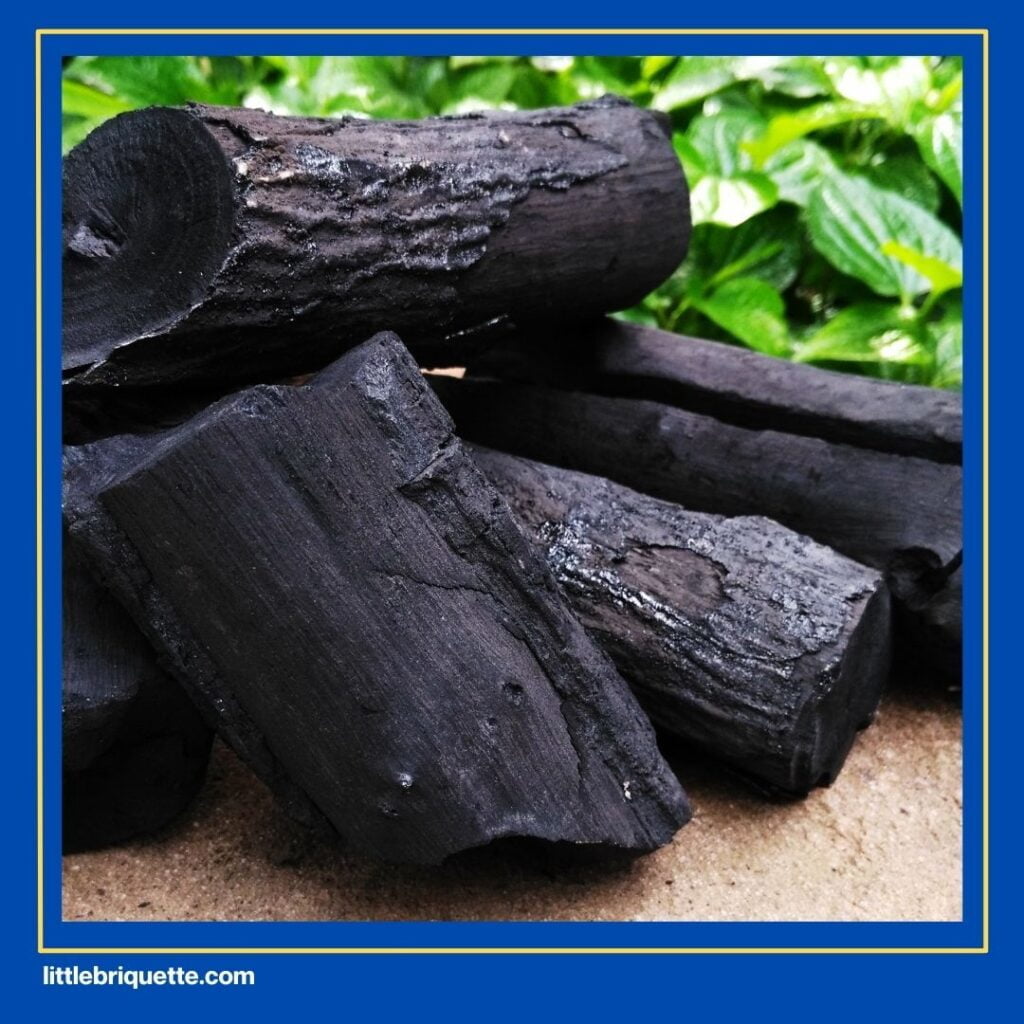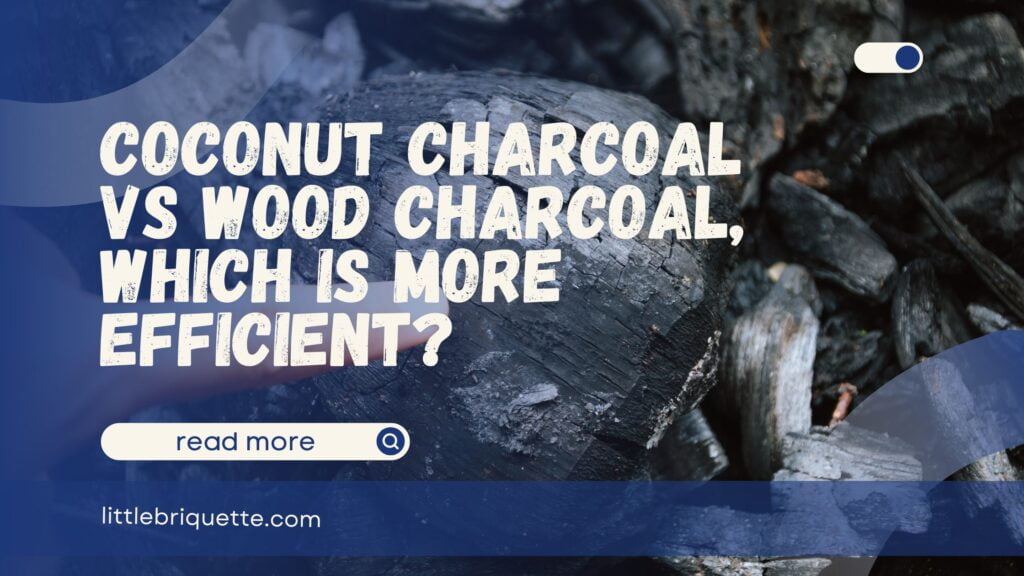Charcoal as a fuel has become an essential part of daily life in various countries, used for cooking, heating, and industrial purposes. However, when it comes to choosing charcoal as a fuel, we often face two main options: coconut charcoal vs wood charcoal. These two fuels have different characteristics and offer varying efficiency potentials. The following will comprehensively discuss the differences between these commonly used fuels.
Coconut Charcoal vs Wood Charcoal
Generally, the differences between coconut charcoal and wood charcoal lie in their production process, characteristics, and usage. By understanding these differences between the two types of fuel, we can evaluate the efficiency of each charcoal type in daily use and its environmental impact.
What is Coconut Charcoal?

Coconut Charcoal is made through the process of pyrolysis, which involves heating coconut shells in a controlled environment with little or no air. This process transforms the coconut shells into carbon by removing most of the water and other organic substances, leaving behind a dense carbon structure with high heat capacity.
Here are the characteristics of coconut charcoal:
- Density: Coconut charcoal generally has a high density, making it heavier and more compact compared to wood charcoal.
- Heat Quality: Coconut charcoal provides relatively stable heat and has a long burning duration when used for cooking. This is because it can maintain a consistent high temperature for an extended period.
- Other Features: Coconut charcoal is known for producing minimal smoke, having a light aroma, and being environmentally friendly.
Coconut charcoal is valued for its efficiency in maintaining a stable heat, producing less smoke, and being suitable for indoor cooking. Despite its various advantages and characteristics, coconut charcoal may have higher production costs compared to wood charcoal, depending on the availability of coconut shells in specific regions.
What is Wood Charcoal?

Wood charcoal is produced by heating wood in a controlled environment with little or no air. This process removes water and other volatile substances from the wood, leaving behind a residue of hard and stable carbon.
Here are the characteristics of wood charcoal:
- Heat Capacity: Wood charcoal varies in heat capacity depending on the type of wood used. Some types of wood charcoal have high heat capacity and are suitable for industrial or large-scale heating purposes.
- Industrial Uses: Wood charcoal is often used in industries such as iron production, metallurgy, and commercial combustion to generate energy.
Wood charcoal has its advantages and disadvantages in both usage and production processes. Its advantages include high heat capacity, making it suitable for applications requiring extreme temperatures like in industry. However, its disadvantages include producing significant smoke and other pollutants when used, making it less suitable for indoor use or cooking purposes.
Efficiency Comparison
The efficiency comparison between coconut charcoal and wood charcoal encompasses several key factors. First, in terms of heat production, wood charcoal generally has a higher heat output compared to coconut charcoal, especially for industrial use or applications requiring high temperatures. However, coconut charcoal is known for its ability to maintain a stable heat for a longer period when used for cooking, albeit with slightly lower heat output.
Second, the burning duration and durability of coconut charcoal are usually longer compared to wood charcoal under similar usage settings. This is due to the higher density of coconut charcoal, which results in slower burning.
Third, environmentally, coconut charcoal tends to produce less smoke and other gas emissions compared to wood charcoal, making it a more environmentally friendly option for domestic and household use. However, both wood charcoal and coconut charcoal have carbon impacts due to their combustion processes, which need to be considered in the context of sustainability.
Overall, the choice between coconut charcoal and wood charcoal depends on specific needs such as heat intensity, burning duration, and environmental considerations, all of which play a crucial role in determining their efficiency and suitability for different applications.
Factors in Coconut Charcoal vs Wood Charcoal
There are two factors that influence the production of coconut charcoal vs wood charcoal: economic factors and environmental factors.
Economic Factors

In terms of production costs and selling prices, coconut charcoal often has higher production costs compared to wood charcoal. This is primarily due to its more complex production process and the requirement for specific coconut shells. However, the selling price of coconut charcoal can vary depending on the availability of raw materials and market demand.
On the other hand, wood charcoal tends to have lower production costs because of its relatively simpler production process and the widespread availability of wood. The selling price of wood charcoal is also more stable and can be cheaper than coconut charcoal, depending on the type of wood and the production location. In the long term, coconut charcoal may be more cost-effective due to its longer heat resistance, reducing the frequency of charcoal replacement.
Environmental Factors

Wood charcoal has a significant impact on deforestation because wood is its primary raw material. Deforestation can lead to widespread ecosystem damage and the loss of habitat for various species. Additionally, both coconut charcoal and wood charcoal release carbon dioxide when burned, contributing to global warming. However, coconut charcoal generally produces lower gas emissions compared to wood charcoal because of its cleaner production process and reduced smoke emissions.
The potential for sustainable use lies in efficiently utilizing coconut shell waste and improving forest sustainability for wood production, while reducing the use of more environmentally damaging fossil fuels. This approach can help mitigate the environmental impacts associated with both types of charcoal production.
Best Choice Based on User Needs
For an ideal scenario in the use of coconut charcoal, it is highly suitable for domestic cooking activities indoors. Coconut charcoal tends to produce less smoke and a more friendly aroma, making it a great choice for cooking food with a natural flavor. Additionally, it has a longer heat endurance compared to wood charcoal, making it ideal for cooking that requires stable temperatures and extended cooking times.
On the other hand, wood charcoal is more recommended for industrial or commercial situations that require high and consistent heat. Its use in industries such as iron production or metallurgy, where temperature precision is crucial for production processes, makes it a more suitable choice due to its high heat capacity and energy efficiency.
Therefore, choosing between coconut charcoal and wood charcoal should be based on specific needs: coconut charcoal for indoor domestic cooking with its low smoke emission and longer heat endurance, and wood charcoal for industrial or commercial settings requiring high and consistent heat for production processes. Each type of charcoal offers distinct advantages depending on the intended use and environmental considerations.
The Best Coconut Charcoal Factory
Coconut charcoal is considered more efficient and sustainable compared to wood charcoal due to its numerous advantages. However, ensuring the quality of coconut charcoal is crucial for effective combustion processes. High-quality coconut charcoal provides a superior user experience.
You can find high-quality coconut charcoal exclusively at Little Briquette. Contact Indonesia’s largest factory at the following number and experience the benefits of using the world’s best coconut charcoal here.

